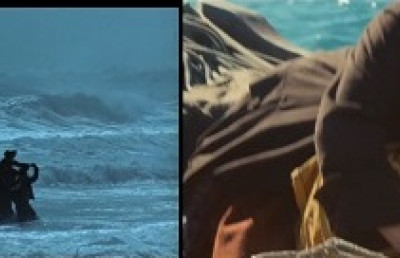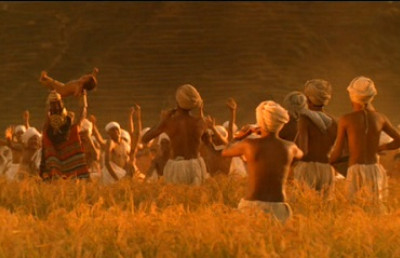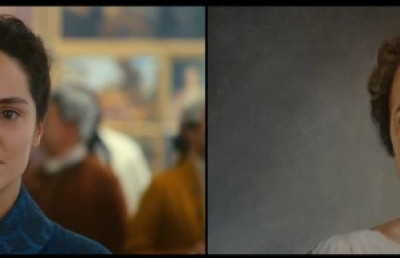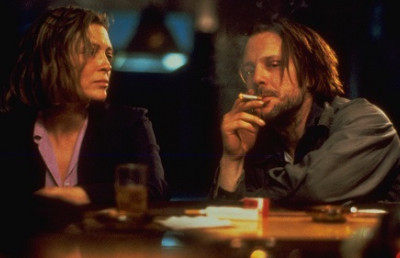La Tête contre les murs (aka, Head Against the Wall) (Georges Franju, 1959)
_(Georges_Franju,_1959)_1000_420_90_c1.jpeg)
La Tête contre les murs (aka, Head Against the Wall) (Georges Franju, 1959)
Delinquent twenty-something François (Jean-Pierre Mockey) is caught red-handed by his wealthy father (Jean Galland) breaking into dad’s home to steal cash to pay off debts (taking a moment to defiantly burn up some random important legal papers right in front of the appalled old man – I mean no sign of the kid acting out or anything) and ends up (at the behest of his très influential pop) committed to a private psychiatric asylum in the country, where he quickly learns that the overriding grim hopelessness felt in the institution is perhaps less from insanity — with a number of the inmates such as epileptic Heurtevent (recently deceased French-fave Charles Aznavour) seeming to suffer from emotional isolation rather than mental derangement – and more from the rigid practices of institution head Dr. Varmont (Pierre Brasseur), leading to François scheming ways to escape…
_(Georges_Franju,_1959)_600_400_90.jpg)
New Wave fave Charles Aznavour
Other than his haunting masterpiece Eyes Without a Face, an art-horror film that moves masterfully between the coldly clinical and the hauntingly lyrical, and his short doc, Blood of the Beasts, which merges peaceful images of the Parisian countryside with uncompromisingly brutal scenes of death in the city slaughter-houses, I hadn’t seen anything of director Franju’s work (I mean, those two unforgettable films were an eyeful already!), so when Le Cinéclub/The Film Society head honcho Phil Spurrell gave a few 16mm recommendations for screening during this latest draconian lockdown, I jumped on this one as a chance to catch up with another of the French director’s work.
As with the previous two films, “La Tête” turned out to be, in similar experimental fashion with ‘”Eyes” and “Beasts”, a cinematic merging of surrealism, shock horror and documentary realism (with the clear use of many real psychiatric in-patients), presented in a style oft-reminiscent of Robert Bresson (with its very austerity at times feeling like a reaching towards religious transcendence), with their formalism I’d say putting Franju on the outskirts from the French New Wave filmmakers soon emerging at the time (and, in fact, I’d argue, allows his work to age better than the much more ‘of the time’ films of his younger contemporaries like Truffaut and Godard, who come across more and more as youthfully pretentious early hipsters).
The film’s intention as a critique of the questionable methods by which society both defined and treated mental illness at the time is the least successful element of the film (and perhaps the most dated) with much of it directly addressed in conversations between Brasseur’s warden-like doctor and the visiting Dr. Emery (Paul Meurisse), who holds a more modern sympathetic view for treating mental illness (though, oddly, as an actor, Meurisse doesn’t strike a particularly more sympathetic physical pose, coming across like a French Jack Webb from the old tv cop show “Dragnet”).
_(Georges_Franju,_1959)_630_354_90.jpg)
Where Franju really succeeds is with haunting quasi-horror movie creations such as the tight-lipped Brasseur’s stubbornly determined doctor, a role he would essay again in “Eyes” for Franju, following practices that the film show as misguided and cruel, with the long driving shots in the country at night, the headlights revealing glimpses of foreboding trees and strange structures (with the fast paced cacophonous score reminiscent of a carnival atmosphere acting in jarring counterpoint), and the evocative near-expressionistic images of imprisoned mental patients. A lot of this haunting imagery Franju would, I now realize, nearly replicate with “Eyes” just a year later, — and do it even more successfully by moving further into the terrain of the overtly horrific and surreal, dropping the pedantic attempts at social criticisms (“Blood” may be overtly on-the-nose with its ‘message’ as well, but it’s undeniable power to simply shock overrides it in that film).
It’s with phantastic images, such as Aznavour’s Heurtevent falling straight back with a sudden epileptic fit during an escape attempt with François, immediately conjuring up the image in reverse of the rise of the phallically-stiff Nosferatu from his coffin, that Franju’s unique cinematic amalgamations come to the fore — with the sudden lack of music and long silent glare at the convulsing body creating the unique experience of something both documentary-like and clinical, and yet expressionistic and horror-influenced all at the same time. And there’s that beautiful moment when the camera lingers on the strange, ethereal visage of the mentally ill girl singing in the church played by none other than Édith Scob (with the director clearly knowing what he had when he picked that face out of the crowd casting her soon after as the ghostly presence wearing the featureless mask in Eyes Without a Face).
_(Georges_Franju,_1959)_630_465_90.jpg)
The mercurial presence of Edith Scob
Where Franju doesn’t stray far from those other New Wave guys with “La Tête” is by having the hope for redemption crystallized in the desire to find a life with a beautiful French girl, in this case then rising-star Anouk Aimée (who would soon explode into international stardom), but he at least stays away from too many scenes of fetishizing her, something the Truffauts and Godards couldn’t get enough of (when not idolizing their own French-ified, yet still clearly American-cinema loner male heroes, like Jean-Paul Belmondo).
With these three films Franju is attempting quite bold (and mostly successful) experiments in the merging of seemingly incongruous cinematic experiences. While the short Blood of the Beasts may be the most in-your-face shocking (as its notoriety speaks to) and Eyes Without a Face the most sublime (as its adored art-horror film status speaks to), La Tête may be the least of the three, but it’s still a considerably worthy and intriguing entry (with an admirably downbeat, elliptical ending) that falls right in with a body of work that is revealing to me what a fascinating filmmaker Franju was.










